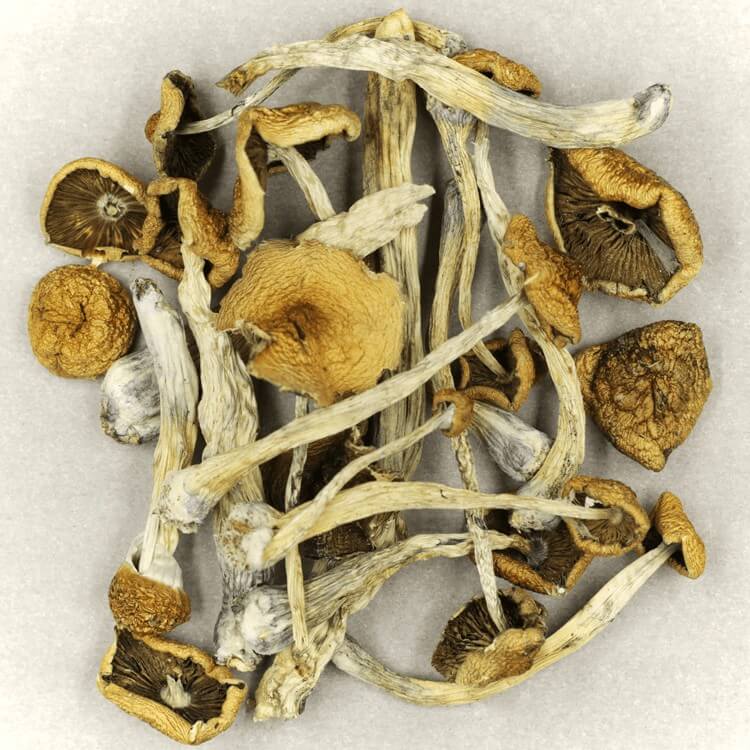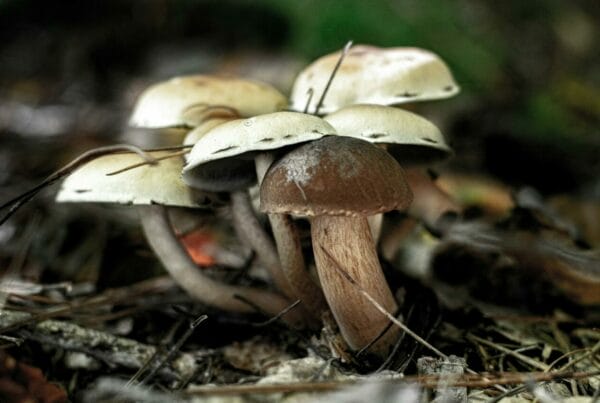Once thought to be purely fantastical, the strength of Psilocybe mexicana has gained recognition in recent years owing to advancements in psilocybin research. The psychedelic research community is consistently unearthing its therapeutic benefits, which is gradually earning it acceptance in the medical field. This expanding discipline is viewed as promising by experts, who are working tirelessly to establish safe dosage recommendations for medicinal uses.
Key Takeaways
- Researchers have utilized advanced techniques, such as liquid chromatography and tandem mass spectrometry, to ascertain the potency of these fungi.
- Psilocybe Mexicana, among other types of mushrooms, is currently being examined in clinical trials to evaluate its potential therapeutic applications.
- An accurate dosage chart requires a thorough understanding of the genetic diversity in magic mushrooms.
Psychedelic Mushrooms: Emerging from Obscurity to Research Triumphs
In the past, only a limited number of ailments were known to be alleviated by Psilocybe Cubensis. Today, however, psilocybin is making significant inroads in discovering its concealed medicinal benefits.
Researchers are harnessing the potential of Psilocybe Mexicana and other potent strains for comprehensive research and clinical trials. This strain, whether studied in vivo or in vitro, effectively reveals the true effects and benefits of this fungal species.
Psychedelics: A New Contender in the Market
What was once hidden is now being unveiled—ongoing breakthroughs and discoveries are captivating the public’s attention, especially those in search of therapeutic solutions. Traditional mental health treatments often fall short, leading individuals to explore more effective alternatives.
Welcome, magic mushrooms.
Patients grappling with mental health concerns are resorting to psilocybin, which has shown potential in treating conditions such as depression, alcohol dependency, anxiety, compulsions, tics, chronic pain, and more.
Currently, medical professionals are investigating novel ways to precisely determine the ideal dosage for safe patient administration. Notably, a research team from the University of Texas has created a model for extracting psilocybin and psilocin concentrations.
It’s feasible to clinically determine the potency of magic mushrooms.
The Distinctive Attributes of Mexicana
Extensive studies have been conducted on Golden Teachers, Blue Meanies, and B-Plus. However, for a more comprehensive understanding of safe magic mushroom usage, it’s crucial to investigate other species as well.
One species that has gained traction in research circles is the Mexicana. It attracts attention not just because it’s among the oldest species, but also due to its relatively low potency, which could potentially meet medical drug standards.
Although the potency of this Mexican strain is less powerful compared to other species, it can still deliver the same effects as the more prevalent strains. As microdosing gains popularity among patients, this strain emerges as a superior choice.
Mexicana exhibits stable levels of psilocybin and psilocin, similar to other strains. So, why prefer this strain over others? The answer lies in its historical and anthropological significance.
Delving into a Deep “Mexican” Past
Back in ancient times, psilocybe mexicana grew naturally in moss. Indigenous communities held these psilocybin mushrooms in high regard for their myriad uses, often associated with mystical or supernatural occurrences.
Let’s focus on Mexican mushrooms. These shrooms were first used over 2000 years ago by the native people of North and Central America. The Aztecs, an ancient ethnic group, labeled these mushrooms as the “food of the Gods,” or “teonanácatl” in their native tongue.
If the Aztecs were around today, they would verify the transformative, emotionally potent, and mentally stabilizing effects of the Mexicana—even without comprehending these contemporary terms.
Despite the various cultivation methods, this mushroom has succeeded in preserving its natural psilocybin concentrations, affirming its genuineness. This genuine quality is a standard that both researchers and psychedelic research institutions greatly appreciate.
Innovative Methods for Testing Psilocybin Content and Potency
A team of ten researchers from the University of Texas at Arlington, along with other research institutions, has pioneered a new method for testing the potency of psychoactive compounds in mushrooms. This innovative technique integrates liquid chromatography and tandem mass spectrometry.
Here are a couple of cutting-edge methods:
- Liquid chromatography refers to a technique used to separate and analyze chemical mixtures, particularly active components found in mushrooms. This approach entails the passage of a liquid sample through a column containing a solid substance, known as the stationary phase. The various chemicals in the sample interact differently with the stationary and mobile phases, causing them to separate at different rates as they traverse the column.
- Spectrometry is typically used to study how matter interacts with electromagnetic radiation at various wavelengths. It detects and quantifies substances based on the specific light wavelengths that molecules absorb and scatter. This method enables the determination of the electronic, vibrational, and rotational states of a chemical.
This approach was employed on five strains of magic mushrooms. The investigators found that the average total psilocybin and psilocin levels across these strains varied from 0.879 to 1.36. These concentrations were higher than those found in many other strains, such as Bull Run and Cambodian. The accuracy of the study was confirmed by comparing its results with those from other independent laboratories.
The congruence of outcomes between the two laboratories further affirmed the reliability of their testing procedure in accurately assessing the potency of the mushrooms.
If validated by experts, this may lead to the introduction of a new set of techniques for existing psychedelic potency tests, serving as an extra safety precaution to prevent incorrect dosage calculations.
Expanding Research to Include Other Species
Extending research to other species can be beneficial. It can improve our knowledge of the health advantages linked to different strains and provide basic information on the effects of less potent mushrooms.
Moreover, it can assist in informing individuals about how varying dosages can impact the psychedelic experience. By contrasting the Mexican strains with more potent ones like Psilocybe Cubensis, scientists can discern how different concentrations of active compounds can affect therapeutic outcomes.
For example, the Blue Meanies strain produces stronger hallucinogenic effects, which could potentially be beneficial in treating conditions such as depression. Alternatively, less potent strains are more suitable for microdosing or more subtle uses, such as improving mood or enhancing focus.
Genetic Diversity Leads to Safer Treatments
It’s often overlooked that different cultivars or varieties have distinct genetic profiles and
The diversity in strength, chemical composition, and effects of hallucinogenic mushrooms is vast. Medical professionals can harness this diversity to select the most suitable type for specific medical applications and adjust dosages based on individual requirements, thus minimizing potential risks and maximizing therapeutic benefits.
For instance, Psilocybe Semilanceata (Liberty Caps) or Psilocybe cyanescens exhibit unique alkaloid profiles that may prove beneficial in alleviating anxiety. On the other hand, certain lab-grown mushrooms could be more effective in managing substance misuse or compulsive behaviours. This rich diversity enables the development of tailored treatments that enhance patient safety and treatment efficacy.
The genetic diversity in hallucinogenic mushrooms, combined with innovative techniques for evaluating potency and identifying strains, plays a pivotal role in formulating safer medical treatments.
Enhancing Safety in Medical Use
Let’s contemplate the potential benefits of safer dosage administration.
- Decreased overdosing incidents: Accurate dosing reduces the risk of overdose, necessitating clearer product labels to avoid consumer misunderstanding.
- Increased predictability: With precise dosing, individuals can better anticipate the potential effects or experiences, reducing intense sensations and anxiety, and enhancing patient satisfaction.
- Uniform measurement: Accurate dosing can lead to a standardized measurement system, enabling people to refer to charts for potential effects with ease.
Experience the Benefits of Accurately Dosed Mushrooms Through Innovative Potency Tests | Buy Magic Mushrooms Online at Buy Magic Mushrooms Canada
If these advanced techniques continue to be utilized, you can expect to avoid unpredictable effects. Enhance your experience with smart online shopping at Buy Magic Mushrooms Canada, where we offer dried mushrooms that promise a tranquil, relaxing psychedelic journey free from excessive psychoactivity. Buy psychedelics online in Canada via Buy Magic Mushrooms Canada.
Frequently Asked Questions
Is there a difference between Big Mexicans and Psilocybe Cubensis?
No, Big Mexicans and Psilocybe Cubensis are distinct strains of mushrooms, so it’s crucial not to confuse the two. Big Mexicans have a higher compound isolation, ranging from 0.5% to 1%, rendering them significantly more potent.
The Psilocybe Mexicana mushroom is quite distinct compared to the Psilocybe Cubensis. Notably, the former often presents with a bell-shaped cap, while the latter typically assumes a conical shape.
What’s the highest concentration level in Mexican mushrooms?
In Mexican mushrooms, the concentration levels of both psilocybin and psilocin can go up to 0.25%. Though this is relatively low and similar to the Golden Teacher strain, it’s enough to induce intense psychedelic experiences that could possibly have health benefits.
How much is a medically safe dose?
Generally, a dose ranging from 1 to 2 grams is recommended. However, this can fluctuate depending on factors such as the method of consumption, individual metabolism, and the specific strain’s potency. Some users opt to take sub-threshold doses between 0.05 (50mg) to 0.025 grams (250mg) to reduce the hallucinogenic effects.





